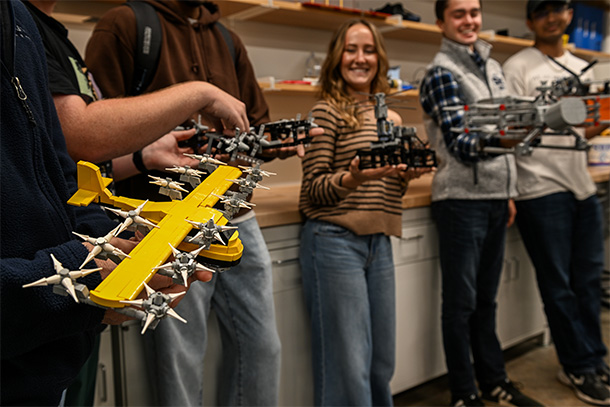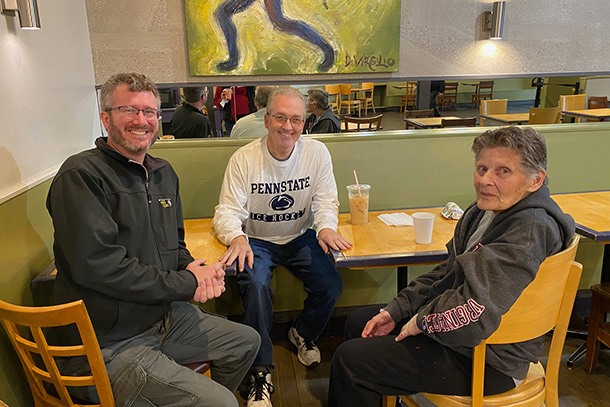
The LEGOneers, seen here holding their vertical flight vehicle LEGO models, are always looking for new opportunities to demonstrate their models of vertical flight vehicles at schools or STEM outreach events. Credit: Poornima Tomy/Penn State.
Brick by brick, LEGOneering team builds interest in STEM careers
Aerospace engineering undergraduates use LEGO models as educational tool for pre-K through grade 12 students
Nov 7, 2024
By Mariah Lucas
UNIVERSITY PARK, Pa. — For Alex Duffy, a second-year aerospace engineering major from Scranton, the pathway to engineering started through building with LEGO bricks. He built structures and custom buildings in elementary school, then later crafted planes, helicopters and military vehicles in high school.
Thinking other young people may also be inspired by using LEGO bricks to join science, technology, engineering and mathematics (STEM) fields, Duffy now leads a team of aerospace engineering undergraduates, called the “LEGOneers,” who build models of vertical flight vehicles and demonstrate them for students of all ages.
“Building with LEGOs made me want to be an aerospace engineer,” Duffy said. “I wanted to design and build in real life what I made out of LEGOs at home.”
Duffy looked for opportunities to get involved in aerospace research right away as an undergraduate student. During his first week at Penn State, Duffy approached Ed Smith, distinguished professor of aerospace engineering and director of the Vertical Lift Research Center of Excellence.
“I said, ‘Alex, you just graduated from high school, what can you do?’” Smith said. “We looked around my office and landed on an old LEGO model of a V-22 Osprey helicopter built over a decade ago by an aerospace engineering alumnus, Conor Marr. I asked him, ‘What about LEGOs?’”
An idea takes flight
At the time that Marr built the V-22 Osprey, Smith had brought LEGO models into the classroom as a learning tool. Smith was inspired to utilize the bricks by his young son, Bryan, who used computer-aided design to build models at home.
The idea took flight: Duffy got to work designing and building a helicopter with a coaxial motor using BrickLink Studio software, which allows users to create a virtual 3D model of a LEGO creation before buying new or used LEGO pieces. He assembled another with two coaxial motors, as well as a motorized tilt rotor helicopter.
“A side-by-side comparison of two different LEGO models can be used to effectively demonstrate the safety benefits of having two motors on a helicopter instead of one,” Duffy said. “They also show the gearing, power transmission and structures of a coaxial helicopter.”
Duffy also created models of aircraft related to NASA’s Dragonfly 2028 mission to explore Titan, one of Saturn’s moons, including three versions of the Dragonfly lander, the Wisk Generation 6 aircraft and the Joby S4 aircraft. One of the versions of the Dragonfly lander features rotating blades, a pivoting radar and a radioisotope thermoelectric generator replica.
Other students joined in, forming a team of nine aerospace engineering undergraduates: Duffy, Sarah Bock, Samantha Coleman, Reed Ladewig, Olivia Motkowski, Adi Nagarajan, Rachel Shifflett, Samay Shingatwar and Firmelia Yamonche.
Deploying the fleet
Once the team assembled a fleet of models, it was time to brainstorm how best to use them as an educational tool.
“We wanted to use the models in a valuable way and decided on using them as a STEM engagement tool to get students interested in engineering,” Bock said. “We began to reach out to local math and science departments to ask to visit the classrooms to talk about engineering as an option for college, so that students could develop their career plans and prepare for them while still in high school.”
Bock’s alma mater, Phillipsburg-Osceola Area High School, was one of the first to take the team up on their offer. The students presented to a group of middle- and high school-aged students there last spring.
The LEGOneers also presented at Duffy’s alma mater, Abington Heights High School, near Scranton, as well as at the Vertical Flight Society’s annual STEM Rotor Day at University Park, where over 200 area middle and high school students interacted with the models.
The team also visited Discovery Space Central Pennsylvania in State College, a science and technology exploration center for kids, during its “Let’s Go with LEGO” summer camp in July. In addition to demonstrating the helicopter models, the LEGOneering team handed out small LEGO helicopter model kits for children ages 6 to 10 to assemble.
“It’s always a lot of fun, because little kids ask the best questions, even questions that college students might not think of,” Bock said.
Propelling forward
Some of the LEGOneering students have built the outreach project into their own individual research experiences.
For example, Shingatwar is working on integrating remote controlling into the models using radio frequencies, allowing the models to be controlled from a distance. Ladewig, on the other hand, is working on a model of a F-35B fighter jet to teach students the principles of flight engineering.
Yamonche, Motkowski and Coleman are designing a presentation to instruct students in pre-K through grade 12 on how the environment — such as temperature, gravity, density and altitude — influences the design and operation of different vehicles, such as helicopters or drones on Earth or octorotors used on the Dragonfly mission to Titan.
Bock is conducting research in aerodynamics and physics to connect with students who are currently in physics and engineering classes in high school. During future presentations, Bock plans to share her experiences working as a flight test engineering intern for the U.S. Navy this past summer.
Duffy presented a paper on the team’s outreach work at the American Society of Engineering Education’s (ASEE) Spring 2024 conference. The team is currently working on another ASEE conference paper that aims to gauge the effectiveness of their presentations in getting students interested in STEM through quantifiable measures like surveys.
“We have accomplished all of this in just two years by spending less than $1000 with discretionary department funds,” Smith said. “I’m looking forward to seeing what we can accomplish going forward as our group continues to grow in numbers and resources.”
Those interested in learning more about the LEGOneers or supporting their efforts can contact Smith at ecs5@psu.edu. Editor's note: "LEGO" is a trademarked term of the Lego Group.

From left to right: Conor Marr, Penn State aerospace engineering doctoral alumnus, Ed Smith, distinguished professor of aerospace engineering, and Meriel Schoenholtz, whose sons own Irving’s Bagels in downtown State College, enjoy a coffee at Irving’s. Marr and Schoenholtz contributed to the idea for a LEGO-based outreach project: Marr created the first LEGO model of a V-22 Osprey as a graduate student, and Schoenholtz provided the initial idea to Smith that parents and teachers play a vital role in encouraging children’s interest in STEM education and employment. Credit: Provided by Ed Smith.


